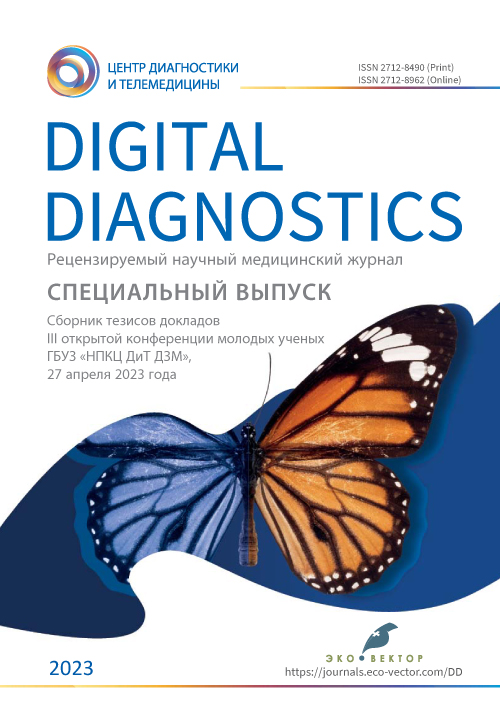Трёхмерная реконструкция костей таза на МРТ-исследованиях
- Авторы: Икрянников Е.О.1
-
Учреждения:
- Научно-практический клинический центр диагностики и телемедицинских технологий
- Выпуск: Том 4, № 1S (2023)
- Страницы: 60-61
- Раздел: Материалы конференции
- Статья получена: 18.05.2023
- Статья одобрена: 18.05.2023
- Статья опубликована: 26.06.2023
- URL: https://jdigitaldiagnostics.com/DD/article/view/430345
- DOI: https://doi.org/10.17816/DD430345
- ID: 430345
Цитировать
Полный текст
Аннотация
Обоснование: пельвиометрия — важная составляющая акушерского обследования, целью которой является прогнозирование несоответствия между размерами предлежащей части плода и таза матери, что приводит к затруднению или невозможности влагалищных родов. Клинически узкий таз — одна из главных причин материнского родового травматизма, перинатальной заболеваемости и смертности.
Цель: создать модель компьютерного зрения для автоматической сегментации костей таза с целью получения трёхмерной реконструкции тазовых костей.
Методы: в работе использовалась нейронная сеть на основе архитектуры 3D U-Net, которая была обучена на Т2 взвешенных изображениях во фронтальной проекции (repetition time (TR) — 7500, echo time (TE) — 130, slice thickness (sl.thk.) — 4 mm, Field-of-view (FOV) — 40×39, matrix — 256×256). Объём выборки составил 49 пациенток. В обучающую выборку вошли 42 исследования, в тестовую — 7. Сегментация зон интереса производилась вручную и была верифицирована специалистом. Размер выборки обоснован достижением репрезентативности данных для получения качественной модели (по индексу Соренсена–Дайса).
Результаты: были получены трёхмерные реконструкции костей таза. Усреднённый индекс Соренсена–Дайса по точности сегментации костей таза на тестовой выборке составил 0,86. Полученный результат обосновал использование нейронной сети на основе 3D U-Net как инструмента, способного воспринимать трёхмерную структуру изображений и проводить качественную сегментацию. Результаты позволяют продолжать работы по автоматизации определения ключевых точек на реконструкциях.
Заключение: создана модель компьютерного зрения для автоматической сегментации костей таза с целью получения трёхмерной реконструкции изображений. Это позволяет выполнить следующий этап исследования, представляющий собой разработку модели определения ключевых точек на изображениях и расстояний между ними.
Ключевые слова
Полный текст
Обоснование: пельвиометрия — важная составляющая акушерского обследования, целью которой является прогнозирование несоответствия между размерами предлежащей части плода и таза матери, что приводит к затруднению или невозможности влагалищных родов. Клинически узкий таз — одна из главных причин материнского родового травматизма, перинатальной заболеваемости и смертности.
Цель: создать модель компьютерного зрения для автоматической сегментации костей таза с целью получения трёхмерной реконструкции тазовых костей.
Методы: в работе использовалась нейронная сеть на основе архитектуры 3D U-Net, которая была обучена на Т2 взвешенных изображениях во фронтальной проекции (repetition time (TR) — 7500, echo time (TE) — 130, slice thickness (sl.thk.) — 4 mm, Field-of-view (FOV) — 40×39, matrix — 256×256). Объём выборки составил 49 пациенток. В обучающую выборку вошли 42 исследования, в тестовую — 7. Сегментация зон интереса производилась вручную и была верифицирована специалистом. Размер выборки обоснован достижением репрезентативности данных для получения качественной модели (по индексу Соренсена–Дайса).
Результаты: были получены трёхмерные реконструкции костей таза. Усреднённый индекс Соренсена–Дайса по точности сегментации костей таза на тестовой выборке составил 0,86. Полученный результат обосновал использование нейронной сети на основе 3D U-Net как инструмента, способного воспринимать трёхмерную структуру изображений и проводить качественную сегментацию. Результаты позволяют продолжать работы по автоматизации определения ключевых точек на реконструкциях.
Заключение: создана модель компьютерного зрения для автоматической сегментации костей таза с целью получения трёхмерной реконструкции изображений. Это позволяет выполнить следующий этап исследования, представляющий собой разработку модели определения ключевых точек на изображениях и расстояний между ними.
Об авторах
Егор Олегович Икрянников
Научно-практический клинический центр диагностики и телемедицинских технологий
Автор, ответственный за переписку.
Email: ikriannikove01@gmail.com
ORCID iD: 0000-0002-1780-6903
Россия, Москва
Список литературы
- Терновой С.К., Волобуев А.И., Куринов С.Б., Панов В.О., Шария М.А. Магнитно-резонансная пельвиометрия // Медицинская визуализация. 2001. № 4. С. 6–12.
- Woo B., Lee M. Comparison of tissue segmentation performance between 2D U-Net and 3D U-Net on brain MR Images // 2021 International Conference on Electronics, Information, and Communication (ICEIC). IEEE, 2021. С. 1–4.
Дополнительные файлы















